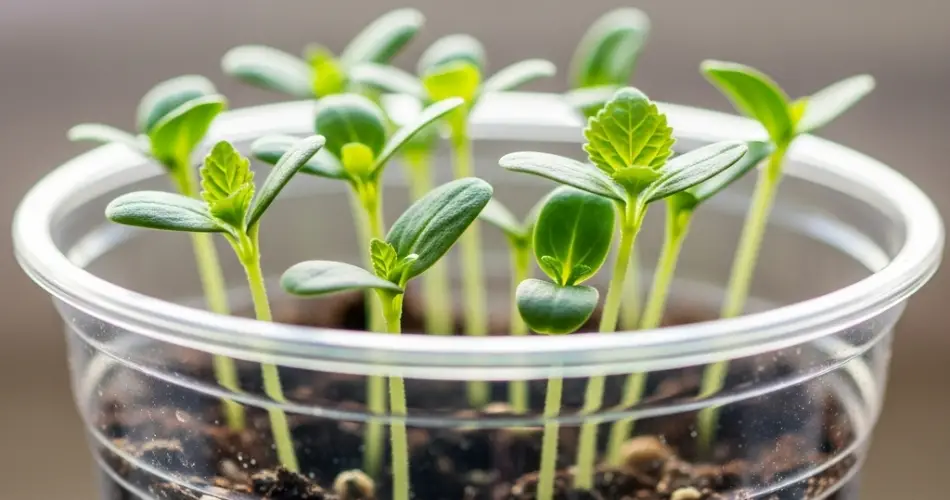Growing strong, healthy seedlings is one of the most crucial stages in gardening. Whether you’re cultivating vegetables, herbs, or flowers, the early development of your plants lays the foundation for a successful harvest. However, many gardeners face common problems during this stage: weak stems, yellowing leaves, fungal diseases, and pest attacks.
The good news is that a simple, natural solution can dramatically boost seedling growth and provide effective protection against common threats—all with just one tablespoon of a household ingredient.
The Secret Ingredient: Hydrogen Peroxide
The powerful yet gentle solution is hydrogen peroxide (H₂O₂)—the same one found in many medicine cabinets. This simple compound, when used correctly in the garden, offers a range of benefits that can stimulate faster seedling growth, disinfect the soil, and deter harmful organisms without the need for harsh chemicals.
How It Works
Hydrogen peroxide is composed of water and an extra oxygen molecule. This additional oxygen boosts root development and enhances oxygenation in the soil, which is vital for young seedlings. The improved oxygen supply helps roots absorb nutrients more efficiently, speeding up growth and creating stronger, more resilient plants.
Its mild antiseptic properties also make hydrogen peroxide a natural disinfectant. It kills bacteria, fungi, and mold spores in the soil, effectively preventing many common diseases that affect seedlings, such as damping-off disease—a fungal issue that often wipes out young plants before they mature.
Additionally, hydrogen peroxide is a deterrent for insect larvae and soil-dwelling pests, keeping your seedlings protected during their most vulnerable phase.
How to Prepare and Use the Solution
You’ll need:
-
1 tablespoon of 3% hydrogen peroxide
-
1 liter of water
-
A spray bottle or watering can
Instructions:
-
Mix the solution – Combine 1 tablespoon of hydrogen peroxide with 1 liter of clean water. Stir thoroughly to ensure even dilution.
-
Apply to soil and leaves – Water your seedlings with the solution, applying it directly to the soil around the base of each plant. You can also lightly mist the foliage, which helps protect against airborne fungi and pests.
-
Repeat regularly – Use the solution once every 5–7 days for ongoing protection and growth stimulation.
Make sure to use 3% hydrogen peroxide, the common drugstore version. Higher concentrations must be diluted further to avoid damaging plants.
When and Where to Use It
This method can be used throughout the seedling phase, from the first sprouting leaves to the moment your plants are ready for transplanting. It is especially effective for:
-
Vegetable seedlings (tomatoes, peppers, cucumbers)
-
Herb seedlings (basil, cilantro, oregano)
-
Flower seedlings (zinnias, marigolds, petunias)
-
Indoor seed trays and greenhouse setups
Hydrogen peroxide is also useful when disinfecting seed-starting equipment, trays, and containers before sowing new seeds.
Additional Seedling Care Tips
While hydrogen peroxide provides a significant boost, your seedlings will thrive best when paired with smart gardening practices:
-
Ensure good drainage – Avoid waterlogged soil to prevent root rot and fungal issues.
-
Provide sufficient light – Place seedlings under grow lights or in a sunny window to encourage strong, upright growth.
-
Maintain warmth – Most seedlings prefer temperatures between 65–75°F (18–24°C).
-
Avoid overcrowding – Thin out seedlings to prevent competition for nutrients and improve air circulation.
What to Expect
After just a couple of applications, many gardeners notice:
-
Faster leaf and root development
-
Increased seedling vigor and size
-
Fewer signs of disease and rot
-
Healthy, green foliage and sturdy stems
Once transplanted into the garden or larger pots, these strong seedlings adapt more quickly and are less likely to suffer from transplant shock.
Safe, Affordable, and Effective
Hydrogen peroxide is inexpensive, easy to find, and safe for both plants and people when used in proper dilution. It breaks down into water and oxygen after use, leaving no harmful residue behind—making it ideal for organic and eco-conscious gardeners.
This one-tablespoon trick is a smart way to supercharge your seedlings’ growth while naturally protecting them from diseases and pests. Instead of relying on synthetic chemicals or costly commercial solutions, you can achieve vigorous plant development using something you already have at home.
Try incorporating this method into your seed-starting routine and enjoy healthier, more productive plants from the very beginning.



